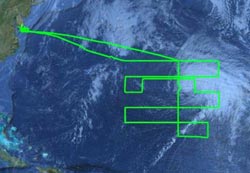NASA eyes Tropical Storm Nadine as watches go up for Azores

NASA's HS3 Mission Global Hawk investigated Nadine on Tropical Storm Nadine on Sept. 14 and 15. During its 22.5 hour flight around Nadine, the Global Hawk covered more than 386,100 square miles going back and forth over the storm in what's called a "lawnmower pattern."<br><br>Credit: NASA<br>
On Sept. 18, 2012, a tropical storm watch is in effect for the islands of Flores and Corvo in the northwestern Azores. A tropical storm watch means that tropical storm conditions are possible within the watch area, generally within 48 hours. The Azores are made up of nine volcanic islands located about 930 miles (1,500 km) west of Lisbon, Portugal, in the North Atlantic Ocean.
NOAA's GOES-13 satellite sits in a fixed position over the eastern U.S. that allows it to monitor the Atlantic Ocean and it captured a visible image of Tropical Storm Nadine on Sept. 18, 2012 at 10:45 a.m. EDT when it was nearing the Azores. Satellite imagery shows that the strongest convection (rising air that forms the thunderstorms that make up the tropical cyclone) is located north of the center of circulation. NOAA manages the GOES series of satellites, and NASA's GOES Project at the NASA Goddard Space Flight Center in Greenbelt, Md. creates images and animations from the satellite data.
In addition to satellite observations, NASA's Hurricane Severe Storms Sentinel (HS3) Mission plans to send one of the unmanned Global Hawk aircraft to investigate Nadine again on Wednesday, Sept. 19. The Global Hawk investigated Nadine on Tropical Storm Nadine on Sept. 14 and 15. During its 22.5 hour flight around Nadine, the Global Hawk covered more than one million square kilometers (386,100 square miles) going back and forth over the storm in what's called a “lawnmower pattern.”
At 11 a.m. EDT on Sept. 18, Tropical Storm Nadine had maximum sustained winds near 60 mph (95 kph), dropping from 70 mph (100 kph) just 24 hours before. It was located about 410 miles (665 km) southwest of the Azores, near 34.4 North and 32.9 East. Nadine has slowed to about half the speed it was moving on Sept. 17 and is now moving to the northeast near 8 mph (13 kph). Minimum central pressure was near 990 millibars.
As the Azores prepare for Nadine's arrival, ocean swells are expected to affect the islands within the next day or so.
Media Contact
More Information:
http://www.nasa.govAll latest news from the category: Earth Sciences
Earth Sciences (also referred to as Geosciences), which deals with basic issues surrounding our planet, plays a vital role in the area of energy and raw materials supply.
Earth Sciences comprises subjects such as geology, geography, geological informatics, paleontology, mineralogy, petrography, crystallography, geophysics, geodesy, glaciology, cartography, photogrammetry, meteorology and seismology, early-warning systems, earthquake research and polar research.
Newest articles

High-energy-density aqueous battery based on halogen multi-electron transfer
Traditional non-aqueous lithium-ion batteries have a high energy density, but their safety is compromised due to the flammable organic electrolytes they utilize. Aqueous batteries use water as the solvent for…

First-ever combined heart pump and pig kidney transplant
…gives new hope to patient with terminal illness. Surgeons at NYU Langone Health performed the first-ever combined mechanical heart pump and gene-edited pig kidney transplant surgery in a 54-year-old woman…

Biophysics: Testing how well biomarkers work
LMU researchers have developed a method to determine how reliably target proteins can be labeled using super-resolution fluorescence microscopy. Modern microscopy techniques make it possible to examine the inner workings…





















